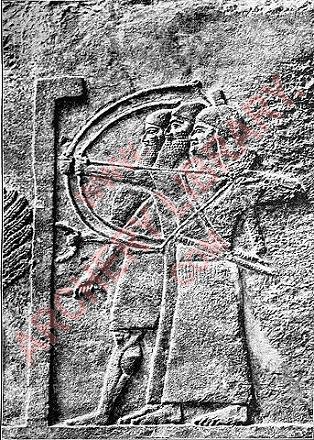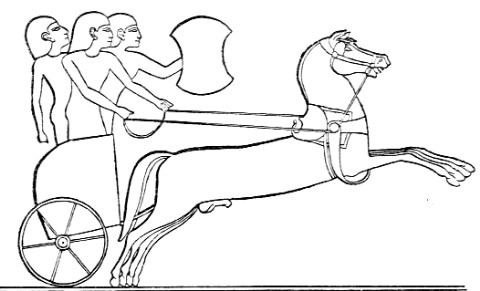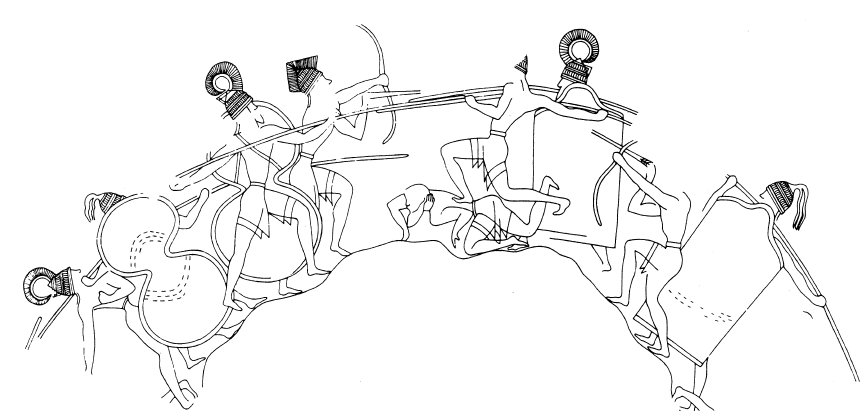|
Laboratory
– Shield-Bearers
In
Sept., 2007 I had got the idea of checking whether, in ancient
armies, there had been instances, other than Ey-de-Net and Dolasilla,
of archers fighting in a team with a shield-bearer devote to their
defense. About this subject, I had proposed a first version of
this “Laboratory” where I concluded that the idea
of protecting Dolasilla by means of a shield-bearer should have
come to the King of Fanes’ mind authonomously, provided
he wasn’t aware of the Assyrians’ methods of combat.
Later on, I received two contributions, one by Alessandro Manfroi,
who, among his various capabilities, is also a skilled archer,
and one by Davide Ermacora, who prospected me the Mycaenean “warrior
duo”, which I blatantly ignored.
| As
a matter of fact, I believed that the only people of the
Ancient Age accustomed to that way of fighting were the
Assyrians. See the detail on the right, See the detail at
right, illustrating a combat team, dated about l'884 B.C.
(today at the British Museum). In this case we have two
archers and a shield-bearer, who propped up the huge structure,
probably wooden,(although John R. Edgerton,
through A. Manfroi, suggests that it might
consist of reeds, and therefore be much lighter) insisting
on the ground and providing also some protection from above.
The bearer looks to be using his left hand for the shield,
while the right one holds an edeged weapon, maybe a short
one; or it may be a second handle used to turn the big thing
around. He wears a cover cap like the archers, but his gown
is short instead of coming down to his feet, and probably
he wears an armour and shin protectors, while the archers
appear to be fighting bare-breasted. Notice the latters'
quivers, strapped across one shoulder, and the swords at
their belts, maybe in a sheath. Last, while one archer and
the shield-bearer wear their classical long beards, the
closer archer wears none. Age difference, national usage,
or just fashion?
At first I had supposed that what we can observe on the
other side of the shield could be a flame, or an explosion.
The same John R. Edgerton provided us with
the complete picture, where we can clearly see that we are
dealing with a tree, and no explosion. A further essential
detail can be acknowledged: in the upper left corner there
is another archer, presumably a foe, who is shooting arrows
from above a wall.
. |
|
 |
 |
The scene,
therefore, doesn’t depict an open-field battle,
but a siege. This circumstance, if it gives a better rationale
to the usage of a so scarcely mobile defensive structure,
on the other hand reduces its value as a comparison reference
with the pair Dolasilla-Ey-de-Net.
Such teams could also be composed by an archer, a shield-bearer
and a swordman; or by two people only, one archer and
the shield-bearer.
|
 |
Then
we have the image of a heavy Assyrian battle-cart (by courtesy
of mr. Bede, from Sidney, Australia), with
four people aboard: two archers, and two shield-bearers.
The latters, however, use a round shield, similar to those
used by infantrymen. |
 |
This type of
combat by small teams was not used, as far as I know,
by other populations, with the exception of the teams
mounted on chariots. What we can see at left is an egyptian
representation of a hittite chariot. We have a charioteer
an presumably a warrior, although the schematic sketch
doesn't allow to understand which weapons does he carry
along; besides, we have the shield-bearer, who makes use
however of a much smaller and nimbler object than the
colossal object of the Assyrian siege unit.
|
In the Homeric description of the war of Troy, it seems that the
chariot team was composed by two people only, the hero, who was
completely armed, and his charioteer. But the Greeks, with the
important exception I will describe later, (I might generalize
and talk of Europeans), don't seem to conceive any combat by small
teams. Heroes fight alone, and the mass all together. Archers,
when they are present, fight each by himself. It seems that archers
never were considered of relevant importance in Greek armies,
as well as in Balkan, or Italic, or Celtic ones; less so, that
any of these populations ever felt the need to assign a man to
the specific task of shielding an archer. The Macedonian phalanx
(yet to come) will later use (several) "shield-bearers"
to shelter its right side, relatively unguarded, but in a quite
different tactical situation.
Davide
Ermacora, however, indicated me the important exception
I was referring to above. It consists of the Mycaenean “warrior
duo”, composed by an archer and a heavily armed infantryman.
Unfortunately, the rich bibliography listed by Davide
is difficult to retrieve, unless one has a specialized university
library at hand. Anyway, I found something, and something was
kindly handed over to me by the same Davide.
Thence, let us see in more detail what happens in the war of Troy
itself.
In
the Iliad, only three Greek heroes are mentioned as archers: Philoctetes,
Meriones and Teucer (there are
also the Locrians [people from the so-named region
of Boeotia not from Locri Epizephiri in Calabria, which was founded
as a Locrian colony many centuries later], about whom in the XIII
chant it is said that they are “arrowing and slinging”).
Ulysses, who in the Odyssey is described as an
exceptional archer, in the Iliad appears having forgotten his
bow at home (as a matter of fact, he will find it again –
in the other poem – at the moment of slaughtering the Proci).
Philoctetes, from Magnesia, who is the lucky
owner of the bow that was Heracles’, leads a party of as
many as fifty archers, but during most of the war remains away
from the battlefield because of a wound;
Meriones, from Crete, who gains the bow contest
in the games on Patroclus’ death, in battle uses however
conventional weapons like sword and lance.
Teucer, brother of Ajax the Telamonian, from
Salamis, on the contrary uses his bow in combat, and this way
he kills several Trojans. His fighting style, that makes him of
special interest in the light of the Fanes’ legend, is that
of sheltering behind his brother’s large shield, uncovering
just to shoot, and immediately returning under cover “like
a child to his mother”. The virtual analogy with the pair
Dolasilla-Ey-de-Net is patent.
More so, Ajax’ shield covers him from chin to ankles, is
shaped “like a tower” and is large enough to shelter
his brother as well. It is composed by seven layers of oxen leather,
covered by a bronze sheet, and is so heavy that the hero –
the most powerful among all Greek warriors – hangs it to
his shoulder with a strap, and even so he must sometimes be helped
by his comrades. Again, the comparison with Ey-de-Net’s
shield, “so heavy that he was the only one who could bear
it” comes immediately to one’s mind.
Several
passages (some of them lexical also) hint at Ajax’ character
representing an archaism in the Iliad: he uses a helm with side
guards and a tower-shaped shield, no body armour and a huge lance
as his only offensive weapon. He is the only hero using that type
of weapons and that fighting style, which is not typical of the
Troy war times, but of the XVI-XV century B.C.! Therefore his
character might be built upon an archetype pertaining to epical
poems of the Mycaenean age, that is, even much older than the
standard version of the Iliad. This is prof. Alessandro
Greco’s conclusion, the top Italian scholar of
Mycaenean culture, who goes as far as defining the pair archer-hoplite
(=a heavily armed infantryman) as the “classical Mycaenean
warrior duo”. I’m expecting to be able to read more
of his writings in the next future.
You can see in the picture here below, derived from an engraving
on a silver cup found at Mycaene in a XV-century B.C. grave (see
Bibl. 8), a fight with tower-shaped shield and lance, involving
archers. |
 |
Notice that the warriors on the right side use a tower-shaped
shield and those on the left an eight-shaped one, but they all
use a lance as their single offensive weapon. Both parties fight
with no other body protection but their helms, of various types
but common to both sides, and don’t appear in “heroic
nudity”, but covered by a short gown. The third warrior
on the left clearly shows how the huge whole-sized shield was
used: it covered the warrior’s back, hanging from a shoulder
strap, so leaving both hands free to handle the lance. Obviously
the fighting style must have been peculiar to suit this type
of weaponry. Then we have the archers, one on each side, with
helms like the hoplites', but naturally bearing no shield. Their
bows show a slight double curvature, and might therefore be
of a composite type (the period might allow this).
It is finally to be noted that the fourth warrior on the right
side is deprived of both shield and bow but is armed with his
lance; he looks like jumping on a comrade’s back (to increase
the dash in handling his lance?). It might have been a peculiar
subterfuge that possibly had been used in a specific war episode,
the subject of a well-known epic narration, which the scene
engraved on the cup was depicting.
We must underline, anyway, that the pair archer-shield bearer
doesn’t appear as having been a typical structure of any
post-Mycaenean army; in the Iliad Ajax and Teucer are the only
instance, and no others are known at later times.
We are apparently allowed to propose the suggestion that those
who detailed the Fanes’ legend were acquainted, if not
with the Homeric poem, at least with the previous ones, upon
which the Iliad must have been based. At the present moment,
however, it’s too early to draw any conclusion: anyway,
this is a totally new strand to explore, that can bring to interesting
developments.
I’m enclosing here the bibliography kindly provided by
prof. Greco, through D. Ermacora
(the last title is the only one I was able to read until now):
1.A. Greco, "Aiace Telamonio e Teucro. Le tecniche
di combattimento nella Grecia Micenea dell'epoca delle tombe
a fossa [Ajax the Telamonian and Teucer. Fighting techniques
in Mycaenean Greece in the pit- graves age], In OMERO tremila
anni dopo, Atti del Congresso di Genova (July 6-8th, 2000),
edited by F. Montanari with the help of P. Ascheri, Roma 2002,
561-578.
2. A. Greco, "La Grecia tra il Bronzo Medio e il Bronzo
Tardo: l'armamento di Aiace e il duo guerriero" [Greece
between East and West: Ajax’ weaponry and the Warrior
Duo] in "Tra Oriente e Occidente", studies in honour
of E. Di Filippo Balestrazzi, Padova 2006, 265-289.
3. A. Greco - M. Cultraro "When Tradition Goes Arm
in Arm with Innovation: Some Reflections on the Mycenaean Warfare",
in ARMS AND ARMOUR THROUGH THE AGES (from the Bronze Age to
Late Antiquity), ANODOS, Studies of the Ancient World, 4-5,
2004-2005 (2007), pp. 45-60.
4. A. Greco, "La Tomba di Aiace" [Ajax’
Grave] in "Eroi eroismi eroizzazioni", Atti del convegno
di Padova (Sept. 18-19th 2006), S.A.R.G.O.N. 2007, 102-112.
5. Hiller S., Scenes of warfare and combat in the art of
Aegean Late Bronze Age. Reflections on typology and development,
In Polemos, Le contexte guerrier en Egee a l'age du bronze,
Actes de la 7° Rencontre
Egeenne int. Univ. Liege, AEGAEUM 19, 1999, 319-330.
6. J. Bennet, Homer and the Bronze Age, In: A new companion
to Homer, I.MORRIS-B. POWELL eds, Leiden-New York Koln, 1997,
511-534.
7. Morris, Homer and the Iron Age, In A new companion
to Homer, I.MORRIS-B. POWELL eds, Leiden-New York Koln, 1997,
pp. 535 e ss.
8. A. Greco, 2006: Aiace, eroe frainteso. [Ajax, a
misunderstood hero] In: Eroi, eroismi, eroizzazioni dalla grecia
antica a Padova e Venezia – Atti del Convegno internazionale
di Padova, Sept. 18-19th 2006: 101-112
I'm also adding a text that I found on the web:
M.P.Nappi, 2002: Note sull’uso di "Ajante"
nell’Iliade, [Remarks on the usage of "Ajante"
in the Iliad] Rivista di cultura classica e medievale, Anno
XIV, N.2
A remark about Dolasilla’s weapons
Alessandro Manfroi proposes that Dolasilla’s
“magic” or “silver” bow may indeed be
a composite bow, imported from Asia by the “dwarfs”
and ended up by chance in the Fanes archer’s hands. This
suggestion, that might well explain the peculiar qualities of
the bow, is neither illogic nor absurd, although a little improbable
and maybe not really necessary. Alessandro also underlines that
the heroine’s arrows, if provided with metal heads, must
have been not only more penetrating, but also, just for having
shifted the baricenter forward, longer-ranged and more accurate.
|
|

